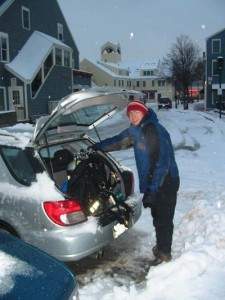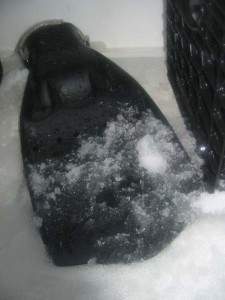The time has come where, at least here in the frozen wasteland of the northeast, we are diving with air temperatures well below the freezing point and often with wind chill factors below zero. This, compounded with water temperatures in the mid to low 30s can have serious consequences if we don’t take care to dive with the proper equipment and procedures. Regulators can freeze, hands rapidly become numb, and hypothermia can set in quickly if diving wet or with a leaking drysuit. There are several equipment and procedural techniques we can use to help combat these problems.
Equipment Considerations
Exposure protection
Dive dry. While there are many high-quality wetsuits available and cold tolerance varies from individual to individual, a well maintained drysuit with a proper undergarment will keep you warmer for a longer period of time. Hypothermia is extremely dangerous. It slows the thinking process down and also is a major contributor to decompression-related injuries.
Wear a proper undergarment under your drysuit. A proper undergarment is a garment made out of a warm material that, in the event of a flood, retains most of its insulation value when wet. 3M?s Thinsulate is an example of this kind of fabric and it retains over 80% of its insulation value when wet. Most manufacturers make Thinsulate lined undergarments including DUI, Viking, Diving Concepts, Bare, and Andy?s. In the winter months, adding a thin wool or polypro layer underneath the drysuit undergarment can help wick moisture away from your skin and keep you much more comfortable during the dive. Personally, I wear a thin Under Armour long sleeve, compression fit shirt . Do not wear cotton in the drysuit. Cotton is a horrible insulator when wet and will actually hold the water against your skin, which when combined with a drysuit leak will quickly lead to hypothermia.
Wear dry gloves. Just like a drysuit will keep you warmer than a wetsuit, dry gloves will keep you warmer than wet gloves. It is important to use a dry glove system that allows you to keep the inner seal intact in case you get a leak in your glove. Without a wrist seal, a small leak in the glove can rapidly lead to a very wet and cold dive. To equalize the gloves, slip a long, thin piece of surgical tubing or shock cord underneath the wrist seal. When possible a hands-off approach to diving is the best way to prevent a leak from developing.
Regulators
Dive with a 1st stage diaphragm regulator that is environmentally sealed. As a general rule, diaphragm regulators are less prone to freezing problems than piston regulators. An environmental seal prevents water from entering the chamber and freezing.
Use a ?downstream? regulator. Downstream regulators will universally freeze in the open position, free-flowing the regulator. While this means loss of gas until you can shut down tank, it also means you have gas to breathe until you can switch to an alternate gas source. Some ?upstream? regulators can freeze in the closed position, suddenly depriving you of gas to breathe. Most regulators manufactured today are of downstream design, with the exception of a few such as Poseidon, which are upstream. Poseidon regulators have an over pressure valve that helps reduce the possibility of lock-up, but my opinion is that it is just another part that can fail when a simpler design works just as well.
Always have a redundant gas supply in case the regulator freezes. Redundancy comes in many forms including a good buddy, doubles, or a pony bottle.
Procedures
Even if it?s going to be above freezing on the day of the dive, keep your tanks indoors the night before. The pressure drop from a tank pressure of 3000 psi to the regulator?s intermediate pressure of 140 psi causes a phenomenon called adiabatic cooling. This can cause a temperature drop of up to 40-50 degrees. If the gas in your tank is at room temperature, the gas you end up breathing is likely coming out at 20 or 30 degrees. Now consider that if your tanks have been sitting in a car overnight, the gas in the tanks might be 10 or 20 degrees. This means, due to adiabatic cooling, the gas you are breathing is 30 or 40 degrees below zero. Not only will this chill your body from the inside much faster, but it will also greatly increase the likelihood of regulators freezing.
If the outside air is below or near the freezing mark, before the dive, do not exhale into the regulator until both the first and second stages are submerged. The moisture in your exhaled breath can collect in the second stage and cause freezing before you even get in the water. This means when you test breathe your regulator, only inhale through it; do not exhale back into it. It is also advisable to even minimize breathing from the regulator at all until it is submerged.
Plan your dive with the assumption that gear will leak and regulators will freeflow.
Plan your dive times shorter. It isn?t enough to say, ?we?ll turn around when one of us gets cold.? By that time, it?s too late. You are now uncomfortably cold and may have a long swim and ascent remaining which equates to getting closer and closer to hypothermia.
Be more conservative. That tough dive you did last August suddenly becomes a whole lot more challenging when it?s 15 degrees outside and the water temperature is 36 degrees.
Conclusion
Make sure you are well prepared before embarking on that cold-weather, cold-water dive. Using the right equipment and procedures can do a whole lot to mitigate the risk of this type of diving.
Photos courtesy of Jeff Schreiber (c) 2006
Tags: cold water, cold water diving, drysuit, freezing, regulators, snow, Techniques, undergarment, underwear, winter
33,812 views



Good to see you blogging Soggy… take care and dive safe.
Nice write up, Aaron.
Can only say, not sure I'll miss the winter diving there…
Aaron, good article. I will start to follow this blog.
Phil Ellis
http://www.divesports.com
Great write-up Soggy. Great tips for all divers.
[…] Great article, Matt. And recently added by a friend of ours: Cold Water Techniques | Thinking Diver […]
Would you like to try a heat exchanger on one of your dives (we call it Mark M)? Have a look here:
http://picasaweb.google.com/Piotr.Kulczakowicz/Mi…
Let me know if you'd be interested and I'll give you more details. Given your understanding of the temperature drop in the procedures section of your blog, you should also inderstand the physics behind this device (and this one has very large heat exchange area).
Thanks for this, very useful information.
It's made me realize it's not a straight forward decision to dive or not to dive, it's not about how tough you are or how much diving you have done but how prepared you are and how aware you are of all the associated factors. I am certainly reconsidering all my future sub-zero diving.
Thanks for this forum
[…] The following article doesn’t speak specifically of Rebreather but it could be a good resource: Cold Water Techniques | Thinking Diver I welcome any article on the topic and rebreathers for ThinkingDiver of course (or any other topic […]
Hey Soggy:
Great write up. And I thought only my fellow PSD's knew about adibiatic effects on tanks. LOL!! Considering my last ice training dive was conducted at -45 degrees temp. and a wind speed of 20 kmh. I'd say that you guys in the NorthEast are doing tropical diving!! LMAO!! And if reg freeze up and free flowing are a concern there's nothing like an old double hose regulator, those work horses keep on ticking!! Just getting harder and harder to find parts these days.
If the outside air is below or near the freezing mark, before the dive, do not exhale into the regulator until both the first and second stages are submerged. The moisture in your exhaled breath can collect in the second stage and cause freezing before you even get in the water. This means when you test breathe your regulator, only inhale through it; do not exhale back into it. It is also advisable to even minimize breathing from the regulator at all until it is submerged.
Plan your dive with the assumption that gear will leak and regulators will freeflow.
THIS IS SO VERY TRUE!!! EVERY DIVER NORTH OF CHICAGO TAKE NOTE!!!!!!!